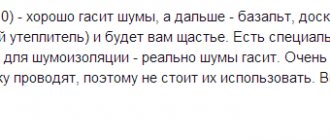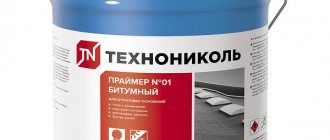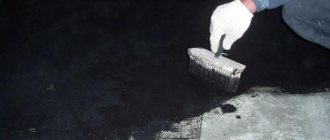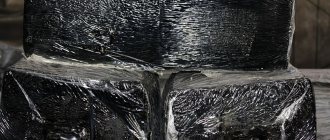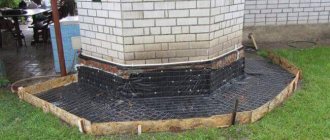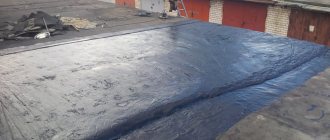Using bitumen in its pure form for waterproofing building structures was unsafe and inconvenient. It is used hot. In its solid state, it is quite fragile and cannot withstand temperature changes.
To get rid of these shortcomings, bitumen is brought into a liquid state by adding organic solvents; after the volatile fractions evaporate, it hardens again. The plasticizer increases elasticity. Now the composition of bitumen mastic includes the main functional substance, organic solvents - white spirit, solvent; mineral thickeners - chalk, asbestos, limestone; plasticizer and other technological additives.
Bitumen waterproofing mastic, which hardens when solvents evaporate, is called “cold”, but there remains a small group of mastics that require heating to 160-180°C. They are called "hot". They have their advantages: low price, lack of pores in the structure, lack of shrinkage, rapid structuring upon cooling. Main categories of “cold” mastics:
- Bitumen mastic. Typical applications are waterproofing underground structures, foundations, etc.;
- Bitumen-polymer mastic. This is bitumen roofing mastic. 40% of such mastics are used on roofing. Although it can be used almost anywhere;
- Bitumen-rubber mastic finds its main application in road construction;
- Polymer mastic has the highest waterproofing and performance characteristics. Service life 20 years. But this is the most expensive type of mastic.
The main task of all mastics - protecting the working surface - is solved by reliable adhesion to the surface (adhesion). But it is impossible to endlessly increase the adhesion of mastics. Therefore, attention turned to preparing the work surface. Before applying mastics, the surface is primed. And primer compositions are called primers.
Bitumen primer is a solution of mineral fillers in organic solvents. To improve its performance, specialized additives have been added to its composition. In essence, this is a low-viscosity bitumen mastic, but the amount and composition of solvents is selected to reduce drying time, as well as to ensure high wetting and penetrating ability.
The composition of the bitumen primer allows you to avoid wasting time on thoroughly preparing the surfaces to be protected. It binds dust, small particles and fills all pores. This significantly increases the adhesion of the waterproof material (mastic) to the base. There is a concentrated primer. Before use, it is diluted in a certain proportion with an organic solvent.
Differences between mastics and primers
The main difference between waterproofing mastics and bitumen primers is their purpose. Bituminous waterproofing mastics are used for protection, and a primer is used to prepare the working surface. And although mastic can be used without a primer, the use of the latter will significantly improve the performance characteristics of the coating and increase its service life.
The undoubted difference between mastics and primers is their different viscosity. Primer is a more liquid bitumen solution. In addition, the composition of organic solvents has been changed. The selection of solvents for primers is aimed at ensuring their high performance qualities.
Application area
The scope of application of bitumen mastics is extremely wide:
- For waterproofing any underground structures and structures, bathrooms, pipelines, basements, wells, swimming pools;
- For roofing bitumen sealing. Without the use of technology, you can cover and reliably protect any roof;
- For reliable fastening of rolled materials;
- For processing wooden parts that are buried in the ground. This is a proven and reliable way to preserve wood from rotting, fungi, mold, etc.;
- For all types of foundations;
- For all types of concrete and reinforced concrete structures;
- Bitumen mastic is an excellent protection against corrosion of all types of metals;
- For asphalt repair. Operation of the roadway is permitted an hour after completion of work.
Depending on the base on which this or that mastic is applied, the appropriate primer is selected. For different materials, concrete, plaster, metal, wood, asphalt, a different primer is used. Often old concrete or cement surfaces have very low adhesion when performing repair work, so pre-treatment with a primer is mandatory. Refusal to use it for the purpose of saving can lead to a sharp loss of the operational qualities of the object, the restoration of which will require significant funds.
The use of a primer guarantees strength, wear resistance and overall reliability of working surface protection.
Bitumen primer is recommended for use when it is necessary to perform waterproofing when carrying out all types of roofing work, on foundations, on floors, on bridge spans, on underground structures and structures, on pipelines. Mastic applied to the primer will reliably protect any metal parts and structures from corrosion.
Material Specifications
Waterproofing mastics have the following technical characteristics:
- Strength of adhesion to the base (adhesion);
- Flexibility on the beam (elasticity);
- Elongation at break;
- Water absorption;
- Waterproof (penetration);
- Softening temperature of dry residue;
- Mass fraction of non-volatile substances;
- Layer thickness;
- Mastic consumption per layer;
- Drying time for one layer;
- Application temperature.
Bitumen primers are usually assessed according to the following technical characteristics:
- Product appearance, description.
- Viscosity, Pa; or density in kg/m3; or conditional viscosity, seconds.
- Water content, description or %.
- Strength of adhesion to the treated surface (adhesion), Points.
- Mass fraction of non-volatile substances (dry residue), %.
- Softening temperature of the dry residue, °C, not less.
- Drying time of the applied layer “to touch” at 20°C, hours.
- Average consumption, l/sq.m.
- Temperature range of application, °C.
Types and technical characteristics of bitumen mastic. Bitumen primer
Bitumen mastic is an indispensable material for waterproofing roofs, walls, foundations and other structures and surfaces. This is a preliminary stage before roof insulation. When choosing a material, you need to take into account the technical characteristics of bitumen mastic and its type: polymer, rubber-bitumen, rubber, etc.
Contents of the article about the types and technical characteristics of bitumen mastic
- Bitumen mastic technical characteristics
- Bitumen-polymer mastic
- Rubber bitumen mastic
- Bitumen rubber mastic
- Bitumen mastic MB-50, technical characteristics
- Mastic primer bitumen or bitumen primer
- Additional material on this topic
- Return to Yandex search
- or write a comment
Bitumen mastic technical characteristics
The options for using bitumen mastic are influenced by the technical characteristics of the material. These are the following parameters: conditional strength, adhesive strength, elongation at break, water absorption, viscosity, resistance to vapor permeation, moisture protection, etc. Let's consider the technical characteristics of bitumen mastic of these types:
- bitumen polymer emulsion mastic MEBIS;
- rubber bitumen mastic MGH-T;
- bitumen rubber mastic MGH-K cold.
There are cold and hot bitumen mastic .
Bitumen mastic technical characteristics, comparison table:
| Indicator name | Water-emulsion bitumen-polymer mastic MEBIS | Rubber bitumen mastic MGH-T | Bitumen-rubber mastic MGH-K |
| Conditional strength, MPa (kgf/cm2), not less | 0.2 | 0.3 | 0.5 |
| Adhesion strength to concrete, MPa (kgf/cm2), not less | 0.4 MPa (4.0 kgf/cm2) | 0.3 MPa (3 kgf/m2) | 0.4 (4.0 kgf/cm2) |
| Elongation at break, %, not less | 100 | 100 | 300 |
| Water absorption within 24 hours by weight, %, no more | 0.5 | 1 | 0.5 |
| Conditional viscosity, seconds, not less | 14-28 | 15 | 15 |
| Mass fraction of non-volatile substances, %, not less | 65 | 65 | 50 |
| Softening temperature, °C, not less | 100 | 100 | 130 |
Bitumen-polymer mastic
Cold bitumen-polymer mastic is made on the basis of a water emulsion of bitumen, modified with latex. It is used for internal and external waterproofing, since the composition does not contain organic solvents.
When dry, the mastic forms a waterproof, plastic, vapor barrier film with high adhesion to wood, concrete, steel, brick and other substrates. Does not lose properties at temperatures from -40 to +100°C.
Purpose of bitumen-polymer mastic cold MEBIS
Mabis bitumen mastic
1. External waterproofing:
- waterproofing of building structures;
- priming (priming) of concrete bases before laying roofing waterproofing materials;
- gluing expanded polystyrene;
- waterproofing of balconies and foundations.
2. Internal waterproofing:
- waterproofing of sanitary facilities;
- waterproofing plasterboard, for example, when leveling walls with plasterboard;
- waterproofing of garages, concrete foundations of buildings, basements and other external structures.
Bitumen-polymer mastic, applied in one layer, dries from 6 to 48 hours, depending on the temperature and humidity of the environment. With decreasing temperature and increasing humidity, the drying time of bitumen-polymer mastic increases.
Bitumen-polymer mastic price
The price for cold bitumen-polymer mastic (MBP-X) is from 1,200 rubles per 18 kg package. For bulk orders the price is reduced.
Rubber bitumen mastic
Rubber-bitumen mastic for cold use is made on the basis of oxidized petroleum bitumen, mineral fillers, fine rubber crumbs, solvent and synthetic rubber.
Purpose of rubber-bitumen mastic:
- roof waterproofing, repair and installation of new roll and mastic roofs made of bituminous materials;
- gluing waterproofing roofing materials;
- sealing of transitions, joints, interfaces;
- waterproofing the blind area of the house;
- obtaining an anti-corrosion coating for a car body (rubber-bitumen mastic + for cars) and other waterproofing work.
mastic , price and consumption
applying bitumen mastic
Rubber bitumen mastic (MBR-X) is relatively inexpensive. The price of rubber-bitumen mastic starts from 830 rubles per package of 17 kg - (45-50 rubles per 1 kg). The consumption of rubber-bitumen mastic per 1 square meter depends on the porosity and structure of the base for waterproofing. Average consumption per 1 layer is from 0.8 to 1 l/m2.
Bitumen rubber mastic
Bitumen-rubber mastic (BRM) is used for gluing fiberboard, chipboard, parquet, plywood, linoleum, and roofing materials. Suitable for anti-corrosion protection of pipelines, concrete, metal and wooden structures.
Bitumen-rubber mastic is a cold-use material. The composition includes synthetic rubbers, bitumens, solvents and fillers. It is elastic, has high adhesive properties and a long service life.
Purpose of bitumen-rubber mastic:
- waterproofing of basements, foundations, concrete, reinforced concrete and metal foundations;
- roof waterproofing and gluing of rolled materials;
- sealing of transitions and joints;
- pothole repair of the road surface.
Bitumen rubber mastic, price
Bitumen-rubber mastic (BRM) is a cheaper mixture. The price for bitumen rubber mastic is from 850 rubles per 16 kg package.
Bitumen mastic MB-50, technical characteristics
Frost-resistant bitumen-oil mastic MB-50 is used for waterproofing foundations, floors, basements, walls, containers, reinforced concrete structures, brickwork and other surfaces. Before use, dilute with white alcohol, gasoline or solvent. Consumption of bitumen mastic MB-50 is 1-1.5 kg/m2.
Characteristics of bitumen-oil mastic MB-50
| Index | Meaning |
| Melting temperature | 50 degrees C |
| Mass Density | 1000 kg\m3 |
| Drying time at +20 degrees C | 36-48 hours |
| Dry residue | 50-60 % |
| Shrinkage by volume | 26-40 % |
| Adhesive strength to concrete | 0.1 mPa (1 kg\cm2) |
| Shelf life | 1 year |
Mastic primer bitumen or bitumen primer
Bitumen primer is a type of primer. Used for better bonding of the surface and the applied mixture. To produce bitumen primer 01, organic solvents and high quality bitumens are used. It has high heat resistance and penetrating ability. Bituminous varnish is also often used.
Bitumen primer 01, technical characteristics
| Index | Meaning |
| Melting temperature | 50 degrees C |
| Mass Density | 1000 kg\m3 |
| Drying time at +20 degrees C | 36-48 hours |
| Dry residue | 50-60 % |
| Shrinkage by volume | 26-40 % |
| Adhesive strength to concrete | 0.1 mPa (1 kg\cm2) |
| Shelf life | 1 year |
Mastic primer bitumen provides a long-term effect, as it is absorbed deep into the structure of the treated surface. Bitumen primer 01 is characterized by fast drying and lack of stickiness. This is an indispensable and easy-to-use material for gluing waterproofing.
Consumption of bitumen primer is 0.25-0.35 l/m2 or 1 l of bitumen primer per 3.33 m2 of surface.
Video: Waterproofing a roof without removing the old bitumen carpet using polyurethane liquid mastics
- History of shingles
- Characteristics of planed square timber
- Plywood: types, properties, application
- Types of fasteners
- Types and functions of voltage stabilizers
- Types of rolled metal
Purpose and advantage of IKOPAL materials
BITUMEN PRIMER IKOPAL
Environmentally friendly, ready-to-use product. Serves for coating roofing and other surfaces prior to waterproofing with bitumen and bitumen-polymer materials, with which it has good compatibility. Its preliminary application improves the quality of installation of built-up roofing and waterproofing coatings.
Due to its good physical permeability, it effectively binds small particles, ensuring high adhesion of waterproofing bitumen and bitumen-polymer mastics to various surfaces. Dries within 3 hours. Consumption per layer is 0.1-0.3 l/sq.m. Can be used at low temperatures, down to -5°C.
Specifications
| Indicator name | Meaning |
| Average consumption, l/sq.m | 0,3 |
| Drying time at +20°С, h, no more | 4 |
| Mass fraction of non-volatile substances, %, not less | 35 |
| Conditional viscosity, seconds | 20-45 |
| Softening temperature of dry residue, °C, not less | plus 70 |
ROOFING MASTIC IKOPAL
The balanced composition includes high-tech roofing bitumen, organic solvents, plasticizer, and other specialized additives. Environmentally friendly, ready-to-eat product. The mastic is specially created for sealing roofing coverings, laying bitumen-polymer coatings, to ensure effective vapor barrier of the roof during the construction of new roofing structures and their repair.
Roofing bitumen mastic IKOPAL is fully compatible with all bitumen and bitumen-polymer materials. Thanks to its thick consistency, it does not spread over uneven surfaces and seams. The content of specialized additives prevents the development of fungi and mold. Excellent adhesion to dry and clean surfaces. Dries within 24 hours.
Specifications
| Indicator name | Meaning |
| Average consumption, kg/sq.m | 1-2 |
| Drying time at +20°С, h | 24-48 |
| Softening temperature of dry residue, °C | plus 90 |
| Mass fraction of non-volatile substances, %, not less | 60 |
| Adhesion strength to concrete, MPa, not less | 0,1 |
| Water absorption for 24 hours, % by weight, no more | 2 |
| Flexibility on a beam with a rounded radius of 5 mm ± 0.2 at a temperature not higher than -5 ºС | corresponds |
| Waterproof at 0.001 MPa pressure for 72 hours | no signs water penetration |
PRIMER SIPLAST
The new generation primer, created on the basis of SBS-modified bitumen and organic solvents, has no analogues on the construction market. Designed for subsequent use of any roofing materials on concrete, wood, and metal surfaces. Can be used to renew old bitumen roofing coverings.
High diffusion qualities, due to the low density of the solution, provide unique penetrating ability and short drying time (1 hour). The penetration depth is increased by 2-3 times compared to other compounds. Increased durability and strength of the coating is achieved due to the presence of an SBS modifier. Consumption per layer is only 0.1-0.25 kg/sq.m. The primer can be used in low temperature conditions. All this made it possible to increase its effectiveness by 50% compared to similar formulations.
Specifications
| Indicator name | Meaning |
| Average consumption, l/sq.m | 0,2 |
| Drying time at +20°С, h, no more | 0,5 |
| Mass fraction of non-volatile substances, %, not less | 50,7 |
| Conditional viscosity, seconds | 16 |
| Penetration depth into concrete base at +23°C, mm | 0,2 |
| Strength of adhesion to concrete base, MPa | 0,27 |
Technology for using bitumen mastic “universal”
Universal mastic combines the properties of hot and cold bitumen resins. Manufacturers offer a ready-to-use composition.
Before processing MBU, you need to prepare the surface: clean off adhering building materials, sand down uneven areas and bumps so that the composition adheres better. If the surface is metal, then you need to clean the rusty areas. When the material thickens, it is enough to dilute it with an organic solvent (for example, purified kerosene in a 1:1 ratio) and mix thoroughly using a drill attachment or a wooden spatula until smooth.
If universal bitumen mastic is used as a primer, then it must be applied to a well-dried, clean base. At a temperature not lower than -15°C, use a brush or fur roller to evenly distribute the layer over the surface, making sure that there are no tears. The layer should not be very thin (at least 1.5 mm); after drying, you can reapply another 2-3 layers every 20 minutes. When waterproofing a roof, the layer thickness is allowed to be at least 10 mm; accordingly, the drying period increases. The coating completely hardens in about 6-7 days.



